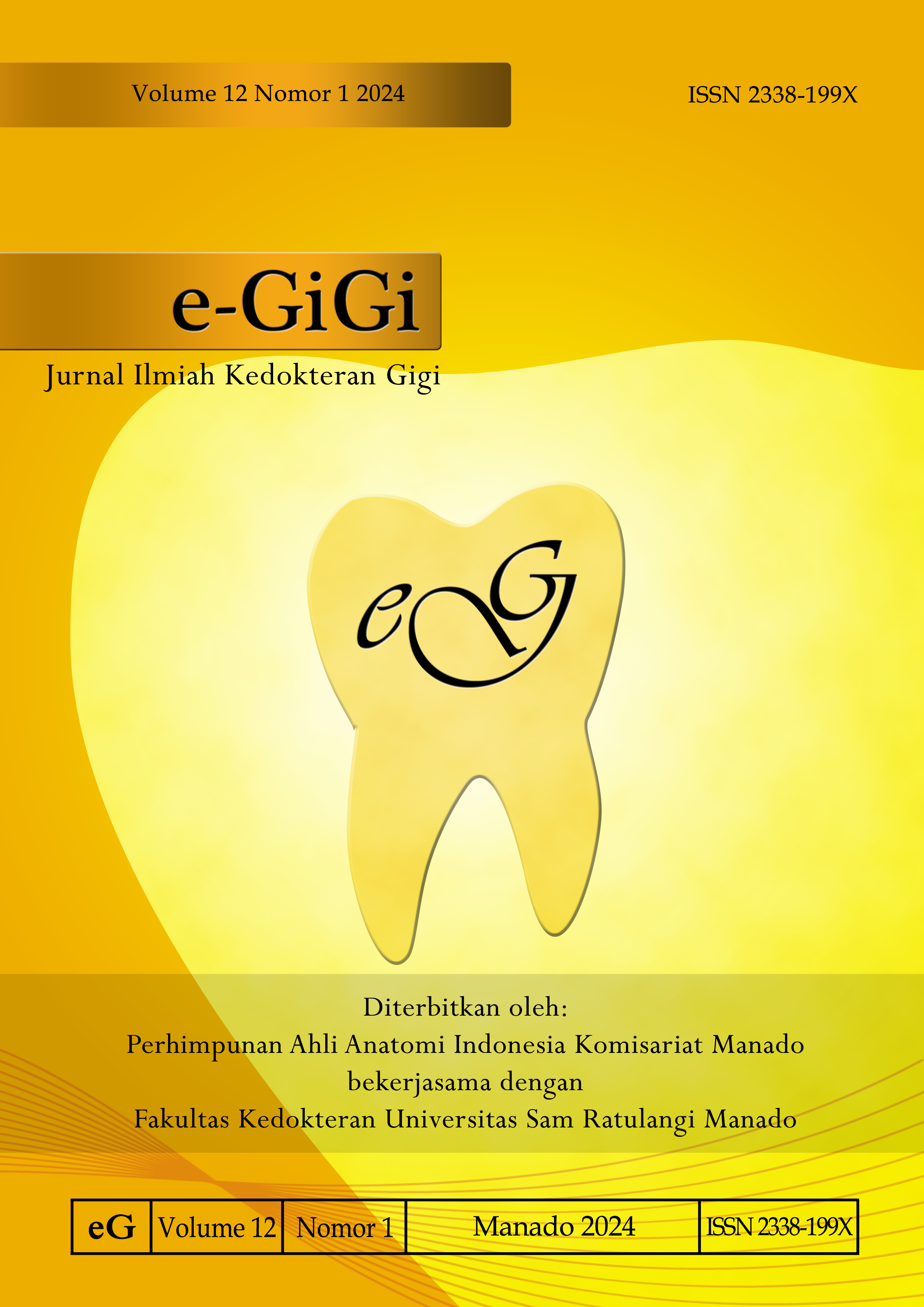Oral Candidiasis Management in a Child with Pacifier Sucking Habit: A Case Report
DOI:
https://doi.org/10.35790/eg.v12i1.49271Abstract
Abstract: Oral candidiasis is a widely known mucosal fungal infection caused by an overgrowth of Candida species. Children and infants are highly more susceptible to Candida infection than adults. We report an oral candidiasis case in a 5-year-old girl with white spots on her lips and tongue. When the white spots were scrapped off, they would be detached leaving red patches on the mucosal surfaces. The patient had pacifier sucking habit and tended to place the pacifier everywhere carelessly. Previously, the patient was treated at a primary healthcare center and received nystatin therapy. However, there was no improvement at all after the therapy. Based on her current and historical conditions, the patient was diagnosed as oral candidiasis, and in this case nystatin administration was ineffective. Therefore, the patient required better oral hygiene management, and the medication given was a gargle containing 0.1% hyaluronic acid. A week after using the gargle without using pacifier anymore, white spots had disappeared, and oral hygiene had improved. Re-control was conducted one month after the first visit and no Candida infection was detected. In conclusion, gargle containing 0.1% hyaluronic acid associated with better dental and oral hygiene is effective to treat oral candidiasis in children.
Keywords: oral candidiasis; children; pacifier sucking habit; gargle containing 0.1% hyaluronic acid
References
Wahyuningsih R, Adawiyah R, Sjam R, Prihartono J, Wulandari ATE, Rozaliyani A, et al. Serious fungal disease incidence and prevalence in Indonesia. Mycoses. 2021;64(10):1203-12. Doi: 10.1111/myc.13304. Epub 2021 Jun 25. PMID: 33971053.
Bertolini M, Dongari-Bagtzoglou A. The relationship of Candida albicans with the oral bacterial microbiome in health and disease. Adv Exp Med Biol. 2019;1197:69-78. Doi: 10.1007/978-3-030-28524-1_6.
Uygun CB, Kadir T, Gumru B. Effect of oral antiseptic agents on phospholipase and proteinase enzymes of Candida albicans. Arch Oral Biol. 2016;32:20-27.i: Available from: https://doi.org/10.1016/ j.archoralbio.2015.11.006.
Kadir T, Can B, Uygun B, Akyu ̈z S. Prevalence of Candida species in Turkish children: relationship betweendietary intake and carriage. Arch Oral Biol. 2005;50(1):33-7. Doi:10.1016/j.archoralbio. 2004.07.004
Pappas PG, Kauffman CA, Andes DR, Clark CJ, Marr KA, Ostrosky-Zeichner L, et al. Clinical practice guideline for the management of candidiasis: 2016 update by the Infectious Diseases Society of Americaexternal icon. Clin Infect Dis. 2016;62(4):e1-50. Doi: 10.1093/cid/civ933.
Benvenuto AF. Kandidiasis lokal dan sistemik pada anak. Jurnal Kedokteran Fakultas Kesehatan Universitas Islam Al-Azhar Mataram. 2016;1(2):128-38. Available from: https://e-journal. unizar.ac.id/index.php/kedokteran/article/view/593
Vila T, Sultan AS, Montelongo JD, Jabra RM. Oral candidiasis: a disease of opportunity. Journal of Fungi [Internet]. 2020;6(1):15. Available from: http://dx.doi.org/10.3390/jof6010015.
Kang JH, KimYY, Chang JY, Kho HS. Influence of hyaluronic acid on anticandidal activities of lysozyme and the peroxidase system. Oral Dis. 2011;17(6):577-53. Doi:10.1111/j.1601-0825.2011.01807.x.
Sakai A, Akifusa S, Itano N, Kimata K, Kawamura T, Koseki T, et al. Potential role of high molecular weight hyaluronan in the anti-Candida activity of human oral epithelial cells. Medical Mycology. 2007;45(1):73-79. Available from: https://doi.org/10.1080/13693780601039607.
Singh A, Verma R, Murari A, Agrawal A. Oral candidiasis: an overview. J Oral Maxillofac Pathol. 2014;18(Suppl 1):S81-5. Doi: 10.4103/0973-029X.141325.
Downloads
Published
How to Cite
Issue
Section
License
Copyright (c) 2023 Nuraeni Hartati, Anrizandy Narwidina, Sri Kuswandari

This work is licensed under a Creative Commons Attribution-NonCommercial 4.0 International License.
COPYRIGHT
Authors who publish with this journal agree to the following terms:
Authors hold their copyright and grant this journal the privilege of first publication, with the work simultaneously licensed under a Creative Commons Attribution License that permits others to impart the work with an acknowledgment of the work's origin and initial publication by this journal.
Authors can enter into separate or additional contractual arrangements for the non-exclusive distribution of the journal's published version of the work (for example, post it to an institutional repository or publish it in a book), with an acknowledgment of its underlying publication in this journal.
Authors are permitted and encouraged to post their work online (for example, in institutional repositories or on their website) as it can lead to productive exchanges, as well as earlier and greater citation of the published work (See The Effect of Open Access).






